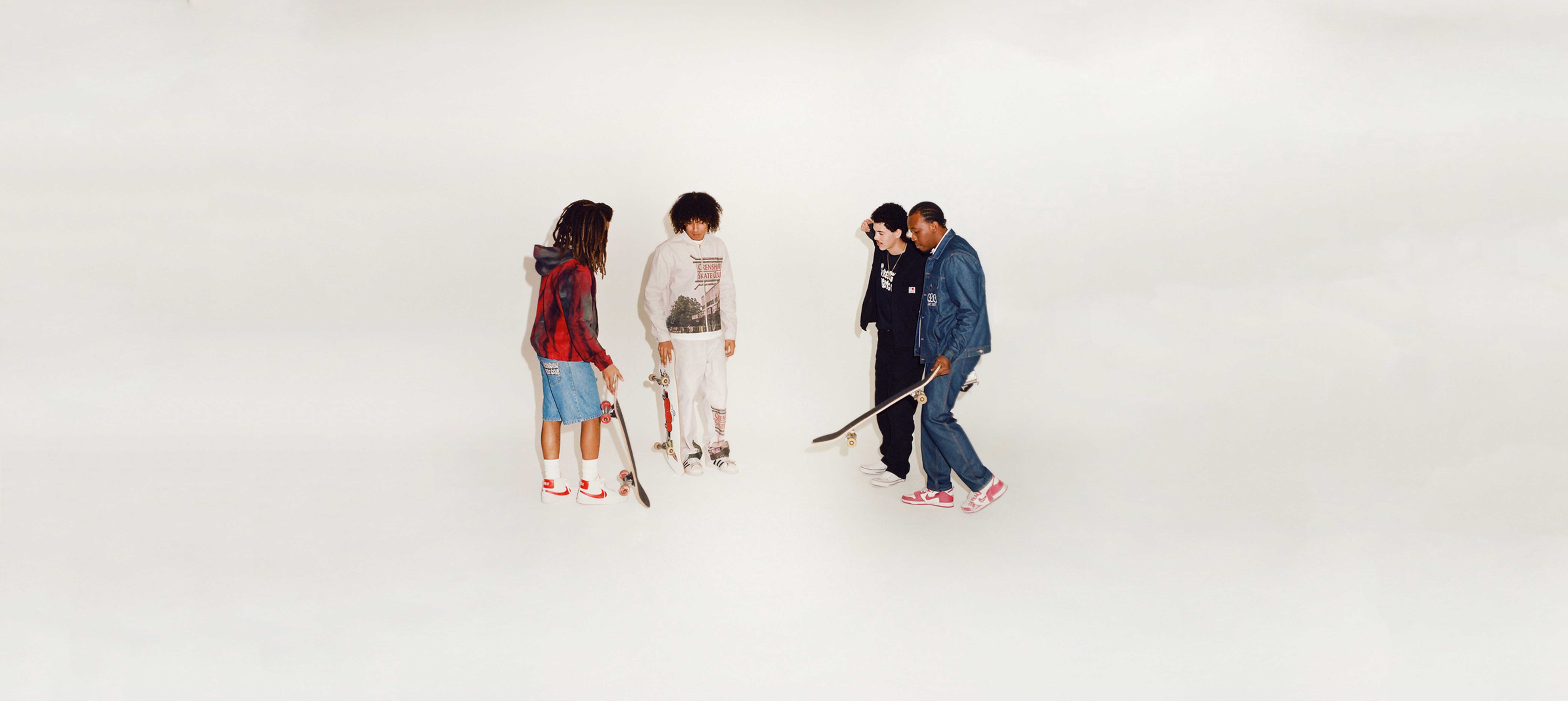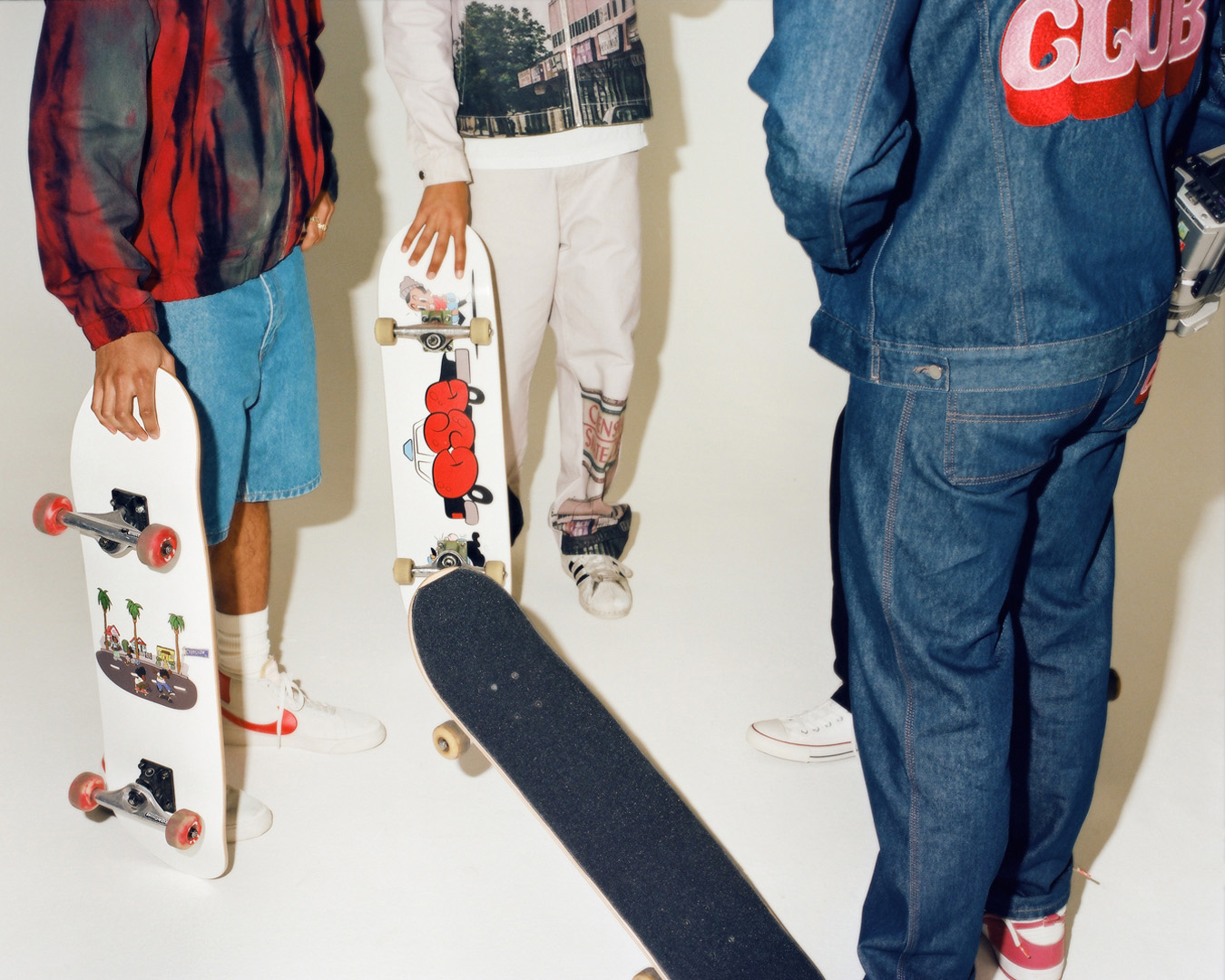
Browns X Crenshaw Skate Club
It’s been five years since a 14-year-old Tobey McIntosh started silkscreening tees to wear out skateboarding with his friends around South Central Los Angeles. Along the way, he built Crenshaw Skate Club, a niche but burgeoning fashion brand underpinned by a homegrown, grassroots mission: to represent and empower inner-city skaters.
Part skate label, part community project, Crenshaw Skate Club counts Justin Bieber as a fan, Supreme as a stockist, and Nike and Lacoste as collaborators. Tobey’s been celebrated as a streetwear prodigy and “an ancient, all-knowing oracle,” all while becoming valedictorian of his high school class and a full-time student at Stanford University.
As Tobey’s grown up, so has his brand. The teenage entrepreneur weaves this coming-of-age story into his new collaboration with Browns for FARFETCH BEAT 009, which allowed Tobey to design far beyond his T-shirts-and-hoodies wheelhouse, graduating to cut-and-sew custom and handmade garments. It’s a partnership that marks an inflection point for the young brand, and a marriage of unexpected but well-suited counterparts: skateboarding and high fashion, LA and London, the global and hyperlocal.

The exclusive 20-piece unisex capsule draws inspiration from Tobey's neighbourhood and CSC’s youthful tenor, with a few Easter eggs peppered in for the IYKYK crowd. Trusted staples like graphic tees and black co-ords are elevated with hand-stitched detailing and organic or recycled fabric. Standout pieces include a pair of appliqué denim jorts and a soft beige three-piece trouser, jacket, and shirt combo, printed with the Crenshaw Square sign.
In between finishing his sophomore year and heading back to London for the CSC x Browns launch with FARFETCH at BaySixty6 Skatepark as part of London Fashion Week, Tobey sat down with us to discuss the new collection, its genesis and why collaborations still matter – when they’re done for the right reasons.

What was it like designing a collection with Browns for your South Central LA-based brand Crenshaw Skate Club, while also being a full-time student at Stanford University?
I had this moment of realisation when we were shooting skate videos for the collab in London, where I could process the gravity of what was going on. I could have never imagined myself and my friends would be skating through the streets of London for work. It’s surreal and at times exhausting, but I wouldn’t trade it for the world.
There are a lot of 3am and 4am nights, both because of the time difference but also my heavy work and course load. My professors have been pretty understanding with any scheduling conflicts that have come up. One of them even placed an order on the website without me knowing, and I showed up to class one day and she was wearing my sweatshirt, so that was pretty cool.
What are you studying at school?
Computer science, but I haven’t declared yet.
What's it like working with a team across the pond?
International business. That was something I wasn’t used to. The UK team is ending their workday as soon as I'm waking up, and vice versa. Our business cultures are a bit different, too. I think in America, there’s less of a work-life balance. In London, when you’re off the clock or on holiday, you’re off off. I met the team in London at a pub, and we ordered pints while passing around food, productive while having a good time. People let their guards down and you can really talk with one another. The pub is important for developing those relationships, but in America, I’ve never had a business meeting at a bar.

Did you learn anything new about UK fashion that you brought into the collection?
When I went in February, I saw a lot more graphic tees and matching sets – people in London love a matching set or tracksuit. I noticed that even before going to London, and it’s why the collection has a lot of pieces that can be worn together, even if a top and bottom don’t match exactly.
How did you make sure Crenshaw and CSC shined through in the clothes?
It was a lot of learning on the fly while sticking to what I know. I don’t operate as a traditional brand and have never shot in a studio with a white backdrop. The people I hire for CSC – from design to content to modelling – are my friends and people I grew up with. It’s always just us out in the streets and hanging out. So when it came time to shoot the collection, I had the idea to bring my friends to London and go skating through the city. Browns got behind it and let us stay true to our process.
I also designed items I actually want to wear. There are a lot of homages and subtle nods that go back to my first-ever collection, like cartoony graphics, things I liked as a 14-year-old. But as I’ve gotten older, my style has evolved, and this capsule allowed me to make pieces that I’ll want to wear years from now. Still, there are some pieces that are a bit out there.

What would you consider to be ‘out there’?
A common thread of ours is the use of Pan-African colours, so we did a dope matching jacket and pant set in green, red and black tie dye. When I was younger, I’d go crazy with it and wear the full set all the time, but these days I might tone it down with a black tee or jeans. A lot of the pieces can stand out on their own or dress up your closet staples.
You've said cut-and-sew has been a goal of yours since childhood. Was there a big learning curve?
Before this, I didn’t have connections to factories or even the vocabulary to communicate with them. Cut-and-sew connotes a higher-quality garment made by expert hands, meaning everything had to be measured out beforehand on a tech pack (the blueprint of a final garment). You can make anything you want as long as you’ve calculated every detail. That was the difficult part for me. What helped was going to stores and thrift shops for cuts and finishes I liked – a sleeve on one piece, a collar on another. It opened up a whole new world for me from a design perspective.

You made skateboard decks, too. How do you feel about treating decks as precious art collectibles?
I’m torn because I’m a skateboarder who also loves this kind of art. I understand the argument that decks are for riding, but I definitely have some decks where I’m like, I can’t skate this, it’s too nice. I’ve made decks before, but these can also hang on your wall, either as a solo or as a three-piece set. Each paints a different scene of life as a CSC member, like hanging out on Crenshaw Boulevard or getting chased by the cops.
Skateboarding is an essential part of the Southern Californian social fabric, but today it’s a worldwide cultural export and a billion-dollar industry. What did it mean to grow up as a skater in Los Angeles?
Skating is the easiest and quickest way to make friends. When you go to a skate park, you know that you have at least one thing in common with every person there. There aren’t too many barriers to entry, and if you need someone to film or teach you, there’s always someone to help out. That carries over off the board. When you see someone wearing a certain logo or brand, you know that’s a fellow skater, and there’s an instant bond. Coming to Stanford was a bit of a reset, but I found my way to the DIY skate park on one of the campus basketball courts where I’ve met all my friends. Skateboarding’s opened so many doors for Crenshaw Skate Club, but also just for me as a person.

Journalist: Mariella Rudi
Photographer & Director: T Bone Fletcher
Stylist: Louis Prier Tisdall
Senior Creative: Yara Heine
Hair: Amidat Giwa
Talent: Tobey Mcintosh
Talent: Erei Reyes
Talent: Emilio Rivas
Talent: Jonathan Alamilla
Editor: Stephen Gurewitz
DP: Elliot Holbrow
Sound Recordist: Olly Jennings
Supervising Producer: Elise Lebrun
Producer: Frances Rollin
Production Manager: Gabriela Peneda
Production Runner: Amy Wilson
1st Photo Assistant: Benedict Moore
2nd Photo Assistant: Nick Payne
Styling Assistant: Charlotte Ghesquiere
Hair Assistant: Gordon Chapples
Skin Assistant: Elise Priestley
Related Reading:
Come Dine With Me… Dansplaining
Brand Stan: Graham Rono On Stone Island
What To Wear: On Vacation
See All Stories: